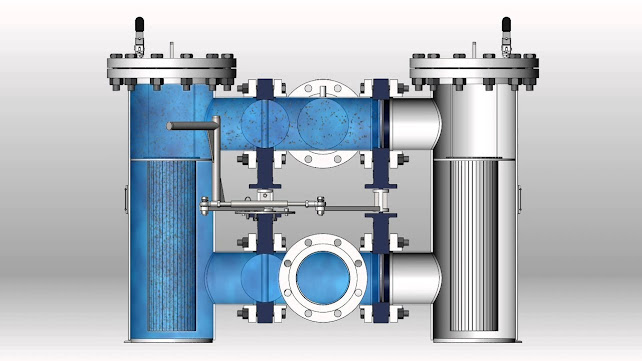STRAINER
Strainers are closed vessels that collect solid particles to be separated while passing a fluid through a removable screen. The screens can collect particles down to 0.001 inch in diameter. Strainers arrest pipeline debris such as scale, rust, jointing compound and weld metal in pipelines, protecting equipment and processes from their harmful effects, thus reducing downtime and maintenance.
TYPES OF STRAINER:
1) Y -TYPE STRAINER
2) BASKET STRAINER
3) DUPLEX STRAINER
4) TEE STRAINER
5) CONICAL STRAINER
6) SELF CLEANING STRAINER
1) Y -TYPE STRAINER :
Y Strainer are cast in sizes ¼" – 24" with Threaded, Socket Weld or Flanged End connections. Strainer are your most economical choice for large debris removal. They are most commonly used in pressurized lines, gas or liquid, but can also be used in suction or vacuum conditions. Y-Strainer has the advantage of being able to be installed in either a horizontal or vertical position. However, in both cases, the screening element or "leg" must be on the "downside" of the strainer body so that entrapped solids can be properly collected and held for disposal.
Standard body materials offered are Cast Iron, Ductile Iron, Cast Steel, Stainless Steel, Chrome-Moly and Bronze. The Y-Strainer are equipped with a blow off port. A ball valve can be fitted to flush debris that is easily removable from the screen and exhaust to atmosphere or a drain system. This feature allows for easy cleaning without interrupting the process. Various Perforations, Mesh or Perforation Mesh combinations or Wedge Wire screens are available to meet your process requirements.
Working of Y-type Strainer
2) BASKET STRAINER
Basket Strainers feature top removal of the screen. The screen is in the form of a basket, with a lifting handle, so that all particulate captured and retained by the screen can be easily removed for disposal. They are intended for applications where large amounts of solids particulate are expected and where the clean-out will be frequent. For easily flushable solids, a modified cone bottom basket can be tilted with automatic or manual blow-down through drain port.This will allow clean-out without removal of the screen, and without interrupting the flow process.
in size from 3/8" – 24" with Threaded, Socket Weld or Flanged End Connections. Standard body materials offered are Cast Iron, Ductile Iron, Cast Steel, Stainless Steel, Chrome-Moly and Bronze. Various Perforations, Mesh or Perforation Mesh combinations baskets are available to meet your process requirements.
Basket Strainers can be equipped with Bolted Covers, Hinged Covers, Clamped Covers, a Davit Lifting Device or other Lifting Device to make removal of large heavy covers safe and efficient.

3) DUPLEX STRAINER
DUPLEX STRAINER are designed for applications where flow cannot be shut down to service the strainer screen. Change over is accomplished by use of butterfly valves.They are very economical because they are fabricated to your specific requirements and with your choice of valves.This arrangement provides a bubble-tight shut off between basket chambers, essential for use in negative head pump suction systems.
They are very economical because they are fabricated to your specific requirements and with your choice of valves.
DUPLEX STRAINER WORKING
4) TEE STRAINER
Tee strainers is a custom fabricated compound strainer designed to remove foreign particles from pipeline.Tee Type Strainers are a low cost solution to large nominal bore straining requirements. They can be mounted into vertical or horizontal piping and can be configured for right-angled applications.
Tee strainers are most commonly supplied with a range of graded filtration levels (fine to coarse or vice-versa) to ensure that the system is running at the required cleanliness level when met with full load. Tee strainers feature either bolted cover or quick opening covers for application suitability.
Tee strainers are used where a compact accessible strainers is needed for protection of pumps, valves and similar equipment.
5) CONICAL STRAINER
Conical strainers are perfect examples of utility tools for new system start-up. These strainers are shaped in the form a cone that tapers towards the end and provides a channel whereby damage by contamination can be ceased. Though temporary in use, this strainer acts as a filter for pipes before they initially cleaned.
a wide variety of conical strainers, more commonly known as Temporary Strainers, which are based on various designs and modern day technology. As inputs these strainers are easily replaceable in a pipe and are considered ideal for escalating the flow in pipe joints. The organization takes special care while manufacturing conical strainers by using perforated sheets and mesh lining.
6) SELF CLEANING STRAINER
Self cleaning Strainer is a motorized unit designed for the continuous removal of suspended solids from intake, process and wastewater flows. These units can handle heavy solids loading with particles as small as 75 microns and as large as 150mm (6" stones).strainers have been installed on applications where backwash strainers have suffered premature clogging, such as black liquor, heavy oils, wax, unprotected river water intakes and boiler waste slurries.
Cleaning is accomplished by a spring-loaded blade and brush system managed by a fully automatic control system. The blades remove larger solids while the brush clean out the individual slots of the wedge wire filtration element, removing smaller particles.The spring-loaded mechanism maintains blade and brush contact with the screen at all times. A separate blowdown timer allows the accumulated solids to be expelled from the bottom of the strainer vessel where they are collected during the scraping cycle. Having a separate blowdown cycle allows our scraper strainer to use far less fluid for cleaning than competing backwash designs.
SELF CLEANING STRAINER WORKING
<< READ OTHER INTERESTING POST >>
PIPING SUPPORTS
EXPANSION LOOP CALCULATION
TYPES OF PUMP
DISTILLATION COLUMN PIPING
PIPE RACK PIPING
TYPES OF GASKET
OIL & GAS PROCESS






























0 Comments: